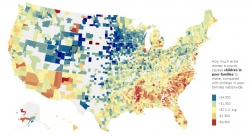May
12
2015

Written by Tina Law
Last week, The New York Times released an interactive dataset comparing what income mobility looks like in different neighborhoods across the country. This dataset, which comes from years of research conducted by The Equality of Opportunity Project, is remarkable in a lot ways. But what struck me the most about this dataset was how even a few miles could drastically change the life chances of a low-income child. I grew up in a low-income family in Sacramento County in California, which ranks average among counties in terms of income mobility. Had my family decided to move 30 miles east to nearby El Dorado County, the dataset shows that I would have expected to earn 11 percent more in income. And if my family had moved about 30 miles south to San Joaquin County, I would have expected to earn far less. For other low-income children, the boundaries of opportunity are much closer and the stakes are even higher: a child in a low-income family in Detroit stands to make 13% less than average by age 26 while a low-income child living 12 miles away in Eastpointe stands to make 6% more than average by that same age.
The dataset shows that place definitely matters—especially for low-income children. However, as Durham-based nonprofit MDC points out in its most recent State of the South blog post, the takeaway can’t just be that we need to carve “escape routes” for the poor. Rather, we need to invest resources and time in building and strengthening local communities, particularly those where a large proportion of the population lives at or below the poverty line. And one key way to bolster the infrastructure of local communities is to strengthen its nonprofit organizations.
In his recent article in The Nonprofit Quarterly, Peter Drier talks about the important role that community-based organizations and coalitions play in advocating for local policies that promote equitable prosperity and that guard against widening wealth and income inequality. He shares Los Angeles Alliance for a New Economy’s (LAANE) successful work in pushing the city of Los Angeles to adopt the nation’s first community benefit agreements, as well as a living wage law for its residents. In the recently released #BlackWorkersMatter report, BMP Co-Director Sean Thomas-Breitfeld also highlights the critical efforts of Los Angeles Black Worker Center and other community-based nonprofits in organizing community members to call for equitable hiring agreements and other worker’s rights. At BMP, our own team in Detroit has been working with The Detroit People’s Platform to advocate for a city-wide community benefits agreement ordinance, as well as to protect the ability of local governments in Michigan to set policies ensuring equitable development.
In order for local nonprofits to build the capacity of their communities, they themselves must have capacity. However, nonprofits located in counties that rank lowest in terms of income mobility tend to be overstretched. For instance, I used data from The National Center for Charitable Statistics to compare the nonprofit landscapes of Fairfax, Virginia—a county that ranks among the best in the nation in terms of income mobility—and Wayne, Michigan—a county that ranks among the worst in terms of income mobility. In 2012, the two counties had similar numbers of registered nonprofits: Fairfax had 1,610 and Wayne had 1,595. Yet, while Fairfax had almost 16 nonprofits for every 10,000 residents, Wayne had half that amount. Brent Nevers observes a similar trend among human service nonprofits in his recent Nonprofit Quarterly article, noting that minority communities tend to be disproportionately served by financially-distressed nonprofits.
Although more research is needed to explore the nonprofit landscapes of communities with varying levels of income mobility, this seems to suggest that communities that could stand to gain the most from a robust nonprofit ecosystem are often supported by the most strained nonprofit networks. As the issue of economic mobility enjoys increased attention from the public and policymakers seek out the kinds of long-term solutions underscored by this landmark dataset, it will be important to not overlook the institutions that have long ensured the health, vitality, and success of many communities: local nonprofit organizations.
Map shown is from The New York Times using data from The Equality of Opportunity Project.
